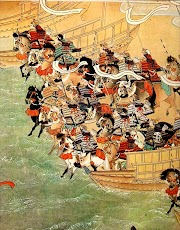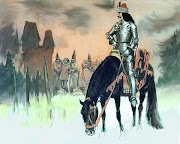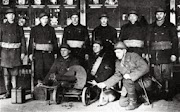Japanese Army artillery in Manchuria, 1931
One of the most unique Imperial Japanese Army (IJA) units to fight in the earliest portion of the great Sino-Japanese conflict of 1931-1945 was the Skull Regiment, known alternatively as the Skull Squadron and as the “Manchurian Stormtroopers” for their unique regimental iconography and symbols. The Japanese Skull Regiment was seemingly inspired by the German Totenkopf, or Death’s Head regiments/brigades of the 18th-20th centuries.
Formed originally during the reign of King Frederick the Great of Prussia (b.1712-1786), the Death’s Head hussars (light cavalry) became an elite branch of the Prussian and the German Empire’s cavalry arm until its collapse in November of 1918. In a bid to break the British and French lines in the West the Imperial German Army created heavily armed shock infantry regiments in 1917-1918, many using the Totenkopf as a badge and regimental icon. These solders came to be known colloquially as assault or stormtroopers. Later the Totenkopf gained international infamy as a military symbol used by Nazi Germany’s fanatical paramilitary forces, first the Sturmabteilung (SA) and later the Waffen-SS.
Manchurian Stormtroopers: the Imperial Japanese Armies' (IJA) Skull Squadron
Service Record: Northern China, Manchuria, & Inner Mongolia
The Skull Regiment or Skull Squadron was led since its inception in the late 1920’s by First Lieutenant Ikagami. They were attached to the large and ever growing Kwantung Army (1906-1945), which had been in China guarding the Manchurian Railway line since 1906. This had been territory won by the Empire of Japan following their decisive defeat of the Russian Empire in Manchuria and Korea during the Russo-Japanese War of 1904-1905. See, the IJA Kwantung Army in China, for more.
First Lieutenant Ikagami-his Death's Head badge can be seen clearly on his left arm
Throughout the Skull Squadron’s service in Northern China, Inner Mongolia, and Manchuria 1930-1933, the Manchurian Stormtroopers engaged in numerous battles and skirmishes with the Chinese National Army and with the many localized bands of anti-Japanese volunteer forces which formed following the invasion of Manchuria by the Kwantung Army in September of 1931. Certainly these Manchurian “bandits”, as named so by the IJA, became the primary antagonists of the Skull Squadron and its commanding officer, the rather enigmatic and aloof Lt. Ikagami. These so-called bandits consisted of both organized Manchurian militias and guerilla-peasant resistance groups, some of whom were armed with swords, spears, and bow & arrows.
Skull Regiment soldier poses with battle flag and Type 38 Arisaka Rifles, 1932
Ikagami and his unit participated in Operation Nekka, the squadron's penultimate campaign honor in the Northern China-Manchurian campaign of 1931-1933. A series of battles erupted beginning in December 1932 and January of 1933 fought between Japan and its Manchukuo Imperial Army allies on one side and the Chinese Republican Army led by Marshall Zhang Xueliang and then General He Yingqin (b.1890-1987). The Kwantung’s Jehol operations force to which the Skull Squadron was attached was commanded by General Nobuyoshi Mutō (b.1868-1933).
The Jehol force was tasked with the taking of the Jehol (Rehe) province within Inner Mongolia closer to the northern reaches of the Great Wall of China. Their specific task was to defeat the Chinese Republican's Northeastern Army in order to annex the territory to the Japanese puppet state of Manchukuo (Manchuria). The conflict in Jehol interceded the Battle for the (eastern) Great Wall of China and preceded the prolonged Inner-Mongolia campaign between Nationalist China and Japan from 1933-1936.
Skull Squadron lining up for review, Manchuria 1932
Equipment & Uniform of the Manchurian Stormtroopers
Skull Squadron in Manchuria 1933-Lt. Ikagami stands in the center just to the right of the regiments flag
Since the Skull Squadron had a significant number of mounted men many of their soldiers would likely have carried the Arisaka 38 carbine instead of the rifle which was lighter and shorter and thus better suited for horseback or armored travel. These mounted men would have been invariably armed with the Type 32 Ko cavalry sabre, forged at the Tokyo Arsenal from 1899 until '42-43. As can been seen in the picture above, many of these men are reasonably well dressed for the frigid temperatures which they certainly experienced in the Northern Chinese theater. Officers could afford to purchase extra cold weather clothing embellished with fur and animal skins whilst the average enlisted Japanese soldier often had to improvise in order to avoid exposure to the elements. The third soldier from the left in the picture wears a cloth wrapping over his nose and mouth to keep his face warm.
Lt. Ikagami poses atop a stout Manchurian pony in 1932 or 1933
Lt. Ikagami, pictured above, is armed as his rank entitles him to be. He wears the heavy winter issue uniform with long black leather gauntlets (fur lined-these were a personal purchase) to protect his hands from the cold and a good pair of leather leggings. A pair of binoculars hangs around his neck on a lanyard and a Japanese Empire and/or Skull Squadron regimental battle banner is at his sides. He is armed with a wakizashi, the traditional Samurai short sword which would have been a civilian purchase or familial sword. Ikagmi and his fellow officers would have been issued the 8mm Type 14 Nambu sidearm which was adopted for official Japanese Army use in 1927.
One of the Skull Squadrons most unique accouterments was the sinister looking red 'Skull & Crossbones' arm band which they wore in several known pictures taken of the regiment during their service in Manchuria, 1931-1933. Though wearing these bands would have been greatly frowned upon by the high command of the Kwantung Army, Ikagami and his unit were most likely given special sanctions as an effective and semi-elite combat formation.
Tenugui banner made in honor of the death of Lt. Ikagami
Suggested Further Reading
Warriors of the Rising Sun: A History of the Japanese Military by Robert B. Edgerton (W.W. Norton, 1997).
The Japanese Army 1931–45 (1) 1931–42, Men-at-Arms #362 Philip Jowett & Stephen Andrew (Osprey Publishing, 2002).
The Rise and Fall of Imperial Japan, 1894-1945, edited by S.L. Mayer (Sunflower, 1988).
Related Posts













